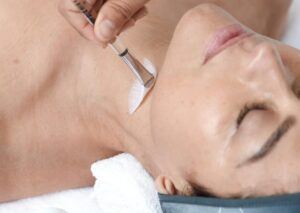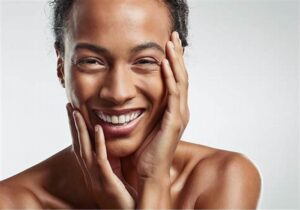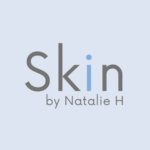The Skin Peel Guide
Your questions answered

This skin peel guide answers the questions you’re most likely to have, so you feel informed, confident, and prepared before your treatment.
All details reflect how I perform skin peels at SKIN by Natalie H, with care, precision, and a focus on visible results.
What is a Skin Peel Treatment?
A skin peel is a professional treatment designed to gently speed up your skin’s natural renewal cycle. Normally, skin renews itself every 28–40 days.
With a peel, I gently accelerate that process by applying a solution that signals your skin to shed old, damaged cells and make way for fresh, healthier ones.
Despite the name, a skin peel does not cause your skin to peel off in sheets. Instead, it works in a controlled, superficial way on the very top layers of skin.
This is why the experience is sometimes called a “peeling process”, even when little or no visible peeling takes place.
Benefits of Skin Peels
Skin peels are versatile treatments that can improve a wide range of skin concerns, including:
Dullness and uneven skin tone
Fine lines and early signs of ageing
Pigmentation and sun damage
Rough or uneven skin texture
Congestion and breakouts
By accelerating cell turnover, a peel helps reveal smoother, clearer, and more radiant skin. Over time and with a course of treatments, peels improve resilience, and refine the overall appearance of the skin.
How do Skin Peels actually work?
A peel works by creating a very controlled and superficial injury to the outermost layers of the skin. This does not damage living tissue, but instead signals the skin to repair itself and renew more quickly.
During this renewal process, the skin may feel tight, dry, or rough, and some clients may notice visible flaking or darkening in certain areas before old cells shed. Others may not peel at all. Both responses are normal—the skin “decides” how it wants to respond at that moment, and either way, the renewal process is still happening beneath the surface.
Even if you have the same peel more than once, your skin may not always react in the same way. After a peel you may flake more noticeably, and another time you may hardly flake at all. Your skin “decides” what it needs at that moment, and both outcomes are equally effective.
Your Pre and Post Care
Before Your Treatment
To get the most from your skin peel session:
Before your peel:
Avoid active skincare (retinoids, strong exfoliants) for 3 days prior.
Do not wax, laser, or shave the area being treated in the 3 days leading up.
Stay out of direct sun exposure and waer your SPF 50.
After your peel:
Keep your skincare simple: gentle cleanser, soothing moisturiser, and broad-spectrum SPF.
Do not pick or peel at flaking skin, let it shed naturally.
Avoid heat, saunas, steam rooms, and intense exercise for 48 hours.
Hold off on active products (retinoids, exfoliants, vitamin C serums) until day 7.
Protect your skin with sunscreen daily, as your skin will be more sensitive to the sun during this renewal period.
Healing is quick for most, and results build over time-skin becomes smoother, stronger, and more refined.
What to expect after a Skin Peel?
There is usually very little downtime. For a few days, you may feel some tightness, dryness, or light flaking. This can last 3–7 days. Makeup is fine from the next day if you apply and remove it gently.
During the renewal process your skin may go through normal, temporary phases such as:
Tightness: new cells are forming and the surface is compacting.
Dryness or flaking: old cells are shedding more quickly.
Rough or “sandpapery” texture: the surface layers are reorganising before they smooth out.
Darkening or patchiness: pigmented cells rise to the surface before they shed.
Dry patches or light crusting: tiny areas of healing where damaged cells are replaced.
- A skin purge/breakout phase: A peel may bring underlying congestion to the surface. The peel has not caused the breakout: it’s simply your skin clearing out what is already there.
Not everyone flakes. Even without visible shedding, your skin is still responding beneath the surface.
Most effects settle within 3–7 days. Once the dryness passes, your skin looks smoother, more even, and refreshed. Whether you flake a lot, a little, or not at all, the renewal process is working.
Skin Peels and Pigmentation
Why do some of my dark spots look darker after a peel?
It is normal for certain pigmented spots to darken in the first few days after a peel.
The treatment speeds up your skin’s renewal process, which means pigment that was sitting just below the surface can be pushed upward before it sheds away.
Not all pigmentation will react in this way, as some sits deeper in the skin.
This temporary darkening is a positive sign that your skin is responding.
Will one peel remove all my pigmentation?
No, one peel cannot remove all pigmentation.
A peel works only on the outermost layers of the skin, so it can lighten marks that are closer to the surface but cannot clear deeper pigmentation in a single step.
For longer-lasting results, peels are often combined with microneedling and supported by daily skincare and sun protection.
This does not mean a complicated or expensive routine. Even a simple and consistent approach at home can make a noticeable difference.
Pigmentation is a complex condition, and lasting results usually come from a combination of professional treatments and supportive home care rather than from one single treatment.
How many peels will I need for pigmentation?
There is no set number of treatments that can clear pigmentation, because it is influenced by many factors such as sun exposure, inflammation, and hormones.
Peels and microneedling work well together to gradually lighten and smooth uneven tone, but lasting improvement also depends on simple daily habits.
Protecting your skin from the sun, reducing inflammation, and following an uncomplicated but effective routine at home all play a vital role.
Results come from this combined approach, not from one treatment or a fixed number of sessions.
Why does pigmentation keep coming back?
Pigmentation is often recurring because it is triggered by sun exposure, hormonal changes, and inflammation.
Even when it fades, new pigment can form if your skin is triggered again, especially without consistent sun protection.
Professional treatments such as peels and microneedling can make a visible difference, but ongoing skincare habits are what keep results stable.
Your treatments are part of a bigger picture, combining in-clinic care with your daily routine to support long-term skin health.
Skin Peels and Ageing
Can a peel make my skin look younger?
Superficial peels cannot stop ageing, but they improve some of its visible signs.
By speeding up cell turnover, a peel smooths rough texture, softens fine lines, and restores a fresher, more even appearance.
The benefit comes from enhancing skin quality, not reversing age itself.
How do peels help with fine lines and texture?
As we age, cell turnover slows and the skin’s surface becomes dull, uneven, and less resilient.
Peels encourage the skin to shed older cells more quickly, revealing newer, healthier cells beneath.
This process softens the look of fine lines and leaves the skin smoother and more refined.
Will one peel make a difference to ageing skin?
A single peel will refresh the skin and give it a noticeable glow, but lasting changes to lines, tone, and firmness take time.
Ageing is complex and shaped by factors such as sun exposure, collagen loss, and lifestyle.
Peels are one effective option, and they often work best when combined with microneedling.
Just as important is what you do daily at home. Consistent skincare, even a simple, cost-effective routine, helps maintain results and supports skin health.
Lifestyle choices, such as sun protection and reducing inflammation, also play a key role.
Meaningful improvement comes from this layered approach, not from a single treatment.
Do peels replace other anti-ageing treatments?
No. Peels are one part of a broader strategy for ageing skin.
They improve surface texture and radiance but cannot address every aspect of ageing on their own.
Microneedling, for example, works deeper in the skin by stimulating collagen and complements the results of peels.
Equally important is daily home care, which does not need to be complicated to be effective.
When combined with supportive lifestyle habits, this consistency makes a real difference.
Ageing skin responds best to a multifaceted, layered approach where in-clinic treatments, home routines, and lifestyle choices all work together over time.
Skin Peels and Breakout Prone Skin
Can a peel clear my acne?
A peel on its own will not cure acne. Acne is driven by several factors, including excess oil, hormones, and inflammation.
What a peel can do is create a clearer surface by helping to unclog pores, calm redness, and reduce some of the buildup that contributes to breakouts.
Think of it as one supportive step rather than a complete solution.
How do peels help with acne-prone skin?
Peels speed up the shedding of dead skin cells, which are often the starting point for blocked pores.
By clearing this layer more efficiently, the pores stay cleaner and are less likely to trap oil.
Peels can also smooth rough patches, reduce the look of post-acne marks, and leave the skin feeling calmer and more balanced.
Will one peel be enough for breakouts?
One peel will freshen the skin and may settle some congestion, but acne-prone skin usually needs more than a single treatment to improve in a lasting way.
Peels can be repeated over time, and they often sit well alongside microneedling, which helps with texture and scarring.
The real difference comes when professional treatments are combined with daily consistency at home, including simple skincare, sun protection, and lifestyle habits that help reduce flare-ups.
Do peels replace other acne treatments?
No. Peels support acne management, but they do not replace medical treatment or lifestyle care when those are needed.
They can, however, fit into a well-rounded plan by helping to clear pores and support healthier skin function.
Acne tends to respond best when different approaches- professional treatments, a steady routine at home, and supportive habits, all work together.
Skin Peels, Purges and Breakouts
Can a peel cause breakouts?
A peel does not cause acne or breakouts, but it can bring underlying congestion to the surface.
This is often called a purge.
Congestion that was already sitting just below the skin can appear as breakouts when the skin speeds through its renewal cycle.
Although it may feel frustrating in the moment, this process is actually positive.
The impurities are being cleared out so the skin can heal and reveal a clearer surface.
What was trapped beneath is finally being released, which allows for healthier renewal in the weeks that follow.
Why did I break out after my peel if my skin looked fine before?
Peels increase cell turnover, which means that blockages or congestion that were not yet visible can be pushed to the surface more quickly.
This can appear as a breakout, but it is not new acne forming, it is your skin clearing what was already there.
While it can feel discouraging at first, this is actually part of the healing process.
By bringing hidden congestion to the surface, your skin is able to release it and move toward a clearer, healthier state.
Will every peel cause a purge or breakout?
Not everyone will experience this. It depends on how much congestion is present beneath the surface.
Some clients notice no breakout at all, while others may see a short-lived flare before the skin clears.
Both responses are normal and show that the skin is responding to treatment.
What should I do if I break out after a peel?
Keep your skincare simple and gentle. Avoid picking at spots, as this can delay healing or leave marks.
Continue with your recommended home care, apply sunscreen daily, and allow your skin to go through its natural renewal process.
The breakout phase usually passes within a week, leaving the skin clearer and healthier.
Still have questions?
If you have any questions after reading The Skin Peel Guide, please WhatsApp me, I am here to help.
All first-time skin peel treatments at SKIN by Natalie H include a full consultation, where I’ll assess your skin and we will choose the right approach for you, together.

Testimonials
Real results, Glowing skin
I’ve had excellent results after a series of Meso TCA skin peels at Natalie H aesthetics- such a professional environment and Natalie is an expert skin care and aesthetic specialist.Highly recommend!
Loving getting treatments with Natalie. It’s been two weeks since my second peel and my skin is starting to see the benefits. Started with the Transbright and now progressed to the Dermalogica Pro Power peel. Can’t wait to continue the journey to glowing skin:)
I have been going to Natalie for a year now, combining microneedling with an uber chemical peel every 6 weeks. My pigmentation has lightened so much and my skin looks unbelievable. If you’re looking for younger, brighter, healthier skin, I 100% recommend Skin by Natalie H in Fourways. She has a wealth of knowledge, is very experienced and the salon is calm and welcoming.
Lovely tranquil and relaxed environment with aromatherapy scents. I had a TC peel done, the Consultant was very careful, she first did a full skin analysis and the procedure was really pleasant. Two weeks later my skin in vibrant, hydrated and as smooth as a babies bum, all my blemishes are gone. Thank you Natalie for the amazing experience and your sheer professionalism. I will be back soon. 💯💥😀
Such a lovely treatment. It was my first time meeting Natalie and my experience was nothing short of amazing - facial peel and neck and shoulder massage. I'm looking for to my skin care journey with her! Mulenga
I had the Dermalogica Pro Power Peel, my skin reacted so well to the treatment. I have a “younger, more glowy face”… as stated by my family after the treatment. Natalie is amazing and very professional
Microneedling and uber face peel. Natalie thank you for a wonderful experience again. Natalie makes me feel so welcome every time. Thank you

